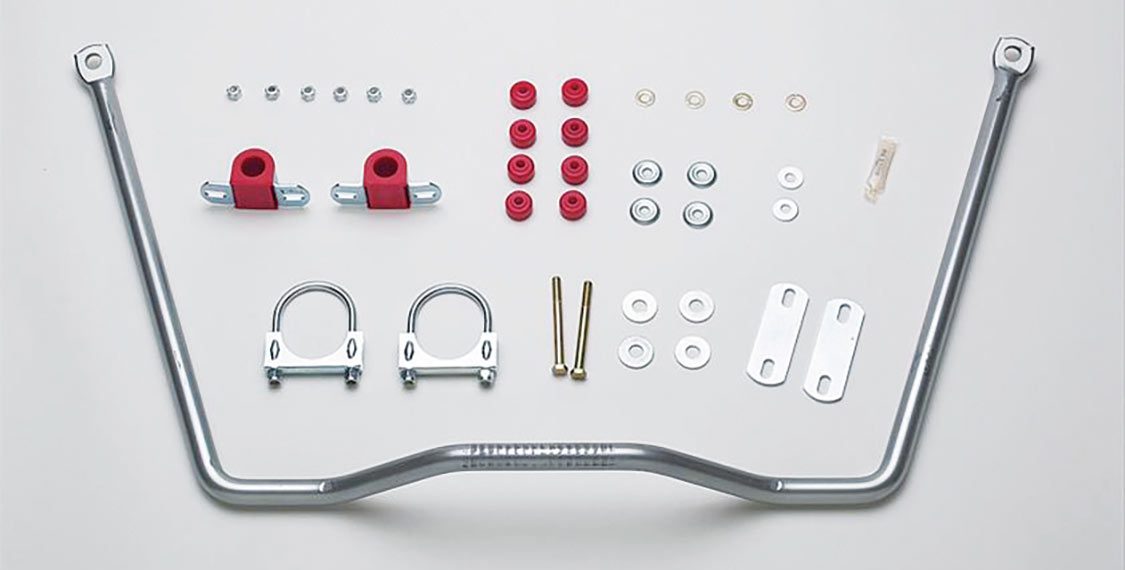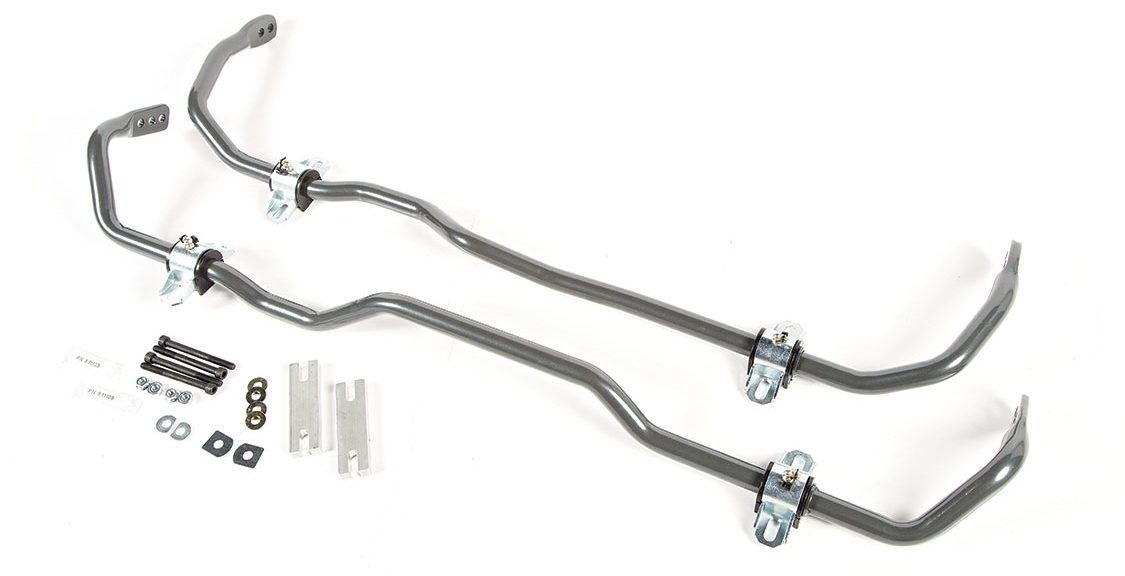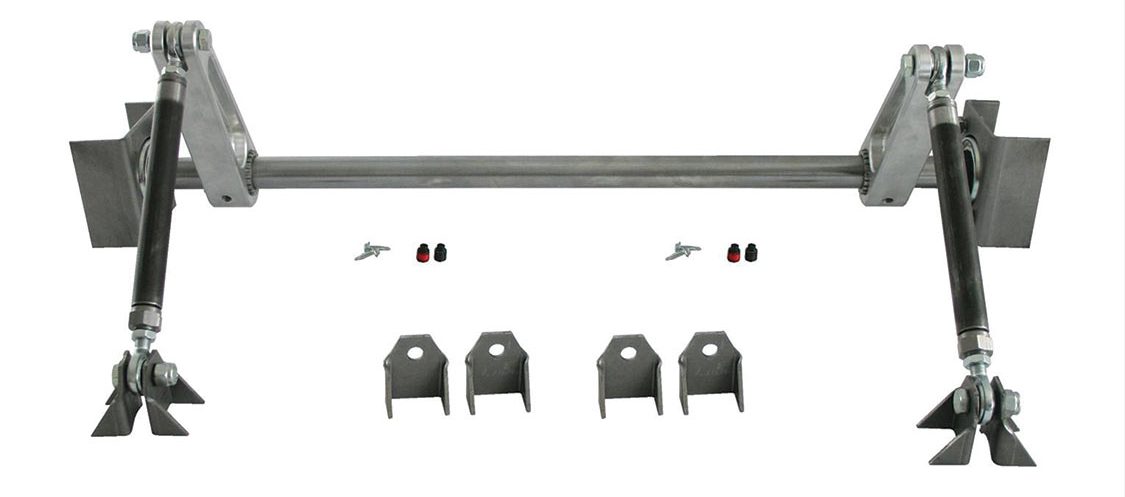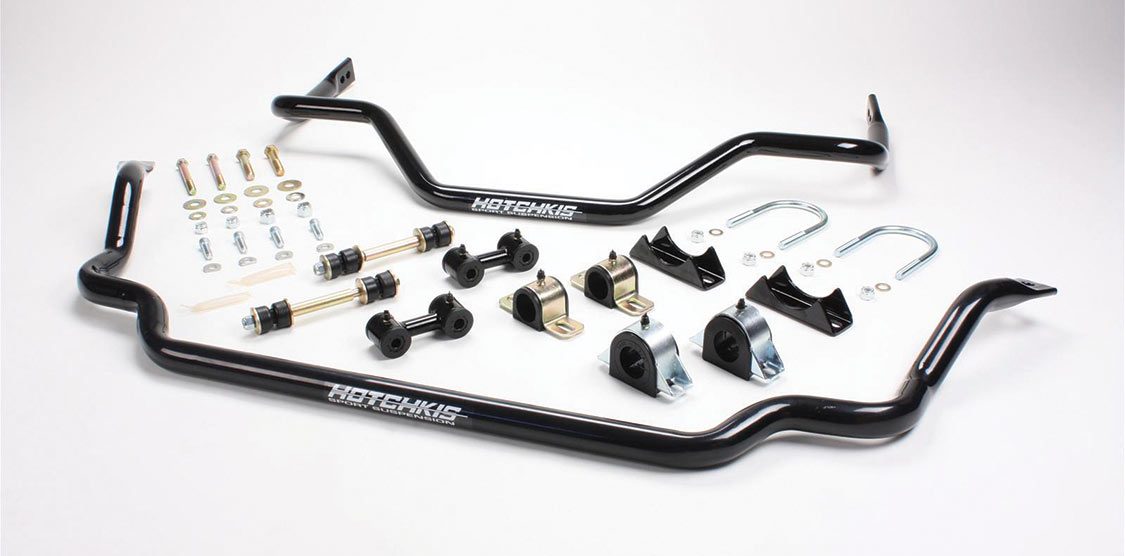Dan Burrill June 07, 2022 All Feature Vehicles

Once you get that high-perform-ance muscle car built and running, the first thing you want to do is take it out for a drive. With the stock suspension, you’re soon going to find that when you push it hard on the curves, the body lean is significant and the handling is all over the road. That’s because Americans as a group want a softer ride, even on a performance car, so the average streetcar rides on soft springs and conservative shocks.

In fact, almost the entire weight of the car is perched on those four springs, where it can bounce and move relative to the tires on the ground. This allows your car to ride comfortably, but it also helps to keep the tires in contact with the road. If you didn’t have any suspension, every bump would send your car bouncing up in the air. But the tradeoff—and there is always a tradeoff—is that inertia makes your car’s body want to roll to the outside of a corner as you drive. At higher speeds that can be unnerving, if not downright dangerous.
An anti-roll bar, also known as an anti-sway bar, sway bar or stabilizer bar, is a basic part of most cars made since the 1960s, and an added part of many performance car suspensions. Sway bars help reduce the body roll of a vehicle during fast cornering or over road irregularities.

A sway bar is usually a torsion spring that resists body roll motions. It is usually constructed of a wide, U-shaped cylindrical steel bar that connects to the body at two points, and at the left and right sides of the suspension. If the left and right wheels move together, the bar rotates about its mounting points. If the wheels move relative to each other, the bar is subjected to torsion and forced to twist. The sway bar encourages the wheels to move up and down together.

Each end of the bar is connected to an end link through a flexible joint. The sway bar end link in turn connects to a spot near a wheel or axle, permitting forces to be transferred from a heavily loaded axle to the opposite side. When you are cornering, sway bars limit the tendency of the outside suspension to compress and the inside suspension to extend. To put it another way, sway bars limit the amount that your car’s body and chassis can roll relative to the tires. A sway bar increases the suspension’s roll stiffness—its resistance to roll in turns.

One design choice in sway bars generates more controversy than any other—that’s whether to use a solid bar or a hollow bar. The difference is just how it sounds—a hollow bar is made of tubing, while a solid bar is made from a solid piece of metal.
The main advantage of a hollow tube sway bar is that the bar will be lighter than a solid bar of the same stiffness. The mistake people often make is to think a hollow bar is stiffer than a solid bar of the same diameter, which is not the case. Here’s the thing—if you’re comparing a solid bar to a hollow bar, don’t compare the total diameter—that’s just part of the equation. With hollow bars, you have to look at wall thickness.

“A 13/8-in. hollow bar is equivalent to a 1¼-in. solid. But the 13/8-in. hollow bar is 6 percent stiffer and 43 percent lighter than the 1¼-in. solid,” says leading suspension manufacturer Hotchkis Sport Suspension.
Hotchkis Sport Suspension anti-sway bars are made from thick, high-carbon steel, which they feel reduces excess chassis movement during launch and tightens up body roll around the corners. These bars come complete with polyurethane bushings and installation hardware. They’re available in individual or complete front or rear kits.
You can get a very effective sway bar upgrade using either a hollow or solid bar. The amount of weight you save is comparatively small, so unless you’re shaving ounces you should pick a quality end-link-adjustable bar that meets your budget.
When you go to select a sway bar, one of the tradeoffs you’re working with is understeer and oversteer. Recall that understeer is when your car isn’t turning as much as you would like—for example, if the front end slides on ice. Oversteer is when your car is rotating more than you expect—like when the rear end slides on ice. If your car has a tendency to oversteer or understeer, you can fix that to some extent by changing or adjusting your sway bars.
To increase understeer, you want to stiffen your front bar or soften your rear bar. To increase oversteer, stiffen the rear bar and soften the front bar. But remember that this is all a tradeoff—the goal is to balance the car’s tendencies. You can increase overall grip with a good set of sway bars, but not infinitely. Also, remember that oversteer and understeer tendencies are affected by many factors in addition to your sway bar choice, including tire choice, alignment, roll center and tire pressure.
Most aftermarket sway bars are plenty stiff enough to dial out oversteer or understeer. But the diameter of the bar is not the whole story. The design and materials in the bar also come into play, so when selecting an aftermarket bar, it’s smart to look at the percentage increase in stiffness over stock for your particular make and model. Your aftermarket parts vendor should be able to tell you that increase over stock.
We’ve mentioned adjustable sway bars, and here’s why you may want to choose an adjustable setup, especially in the rear end. By placing two or more mounting holes along the lever arm of the bar, you can adjust the stiffness by moving the end links up or down the arm. Moving the end links closer to the end of the bar makes the bar softer, while moving the end links away from the end stiffens up the bar.
The advantage to this is that if you set your car up for a little bit of oversteer on dry pavement with a stiff rear bar, you may find that it’s dangerously tail-happy in the rain. So, you can get an adjustable bar that delivers predictable control on the soft setting, and then easily adjust the stiffness up when conditions permit.
One other upgrade that costs very little and makes a huge difference with aftermarket bars is to install adjustable drop links on both sway bars. Your sway bars ride above or below your front and rear lower control arms, and the ends of the bars are connected to the suspension components with drop links.
Most stock drop links are fixed-length with balljoint bushings. You can remove these easily and replace them with adjustable-length links. Then simply sit in your car and have a friend adjust the drop links until the bar and link are about perpendicular to each other and there’s no stress on the sway bars. Be sure to check that the sway bars and links do not bind or interfere with other components. Easy.
You can also use your adjustable links to create preload to help your car turn left or right, but improving one happens at the expense of the other, so be sure you understand the tradeoff.

The benefit to adjustable end links is that your body places weight on the driver’s side of the car. That preloads the suspension, making right and left cornering different. By adjusting the stress out of your bars, you can have your car truly set to zero when at rest. You can also use your adjustable links to create preload to help your car turn left or right, but improving one happens at the expense of the other, so be sure you understand the tradeoff.
For those who are going racing or want the maximum performance, Chris Alston’s Chassisworks has developed different styles of rear anti-roll bars for use with their g-Bar/g-Link canted-rear-suspension systems. The first, a solid, adjustable rate bar mounted to the frame rearward of the rear-end housing. The second, a splined-end, tubular bar mounted to the rear-end housing, below the axle.
“Whatever your plans are for performance, we are the people to see,” says Alston. We’ve developed complete suspension packages that are the ultimate for road or track, including drag racing.

One other company that is on the cutting edge is Competition Engineering. Here’s what their marketing crew had to say: “With our anti-sway bars, you will drive straighter off the starting line and show an improvement in the first 60 ft. times. These Competition Engineering Magnum series anti-roll bars are designed to eliminate body roll during hard launches at the drag strip.”
The Magnum series features formed, heavy-gauge frame mounts, enabling you to install the torsion tube through the frame rails for increased strength. Billet aluminum arms are attached with special incorporated splines to prevent the arms from slipping on the torsion tube. Additional features include: 4130 chromoly torsion tube, two adjustable splined billet aluminum arms, two mounting brackets, two adjustable links, four rod ends, four weld-in threaded adjusters, two flange-mounted bearings and all the installation hardware.
This issue we’re not covering anti-sway bar installation, that topic is worth an entire article on its own. Depending on which sway bar you decide to use, you’ll really want access to a lift to do this job. We’d rate this one as “money well spent” to have a professional install your new rear bar for you. Shop time to do this job depends on which unit you decide to use.
Hotchkis Sport Suspension West
8633 Sorensen Ave.
Santa Fe Springs, CA 90670
Hotchkis Sport Suspension East
9075 Highway 152
Mooresville, NC 28115
(877) 466-7655
www.hotchkis.net
QA1
21730 Hanover Ave.
Lakeville, MN 55044
(800) 721-7761
www.qa1.net
Total Control Products—Chris Alston’s Chassisworks
8661 Younger Creek Dr.
Sacramento, CA 95828
(888) 388-0297
www.cachassisworks.com
Belltech
1075 North Ave.
Sanger, CA 93657|
(800) 445-3767
www.belltech.com
Competition Engineering
80 Carter Dr.
Guilford, CT 06437
(203) 453-6571
www.competitionengineering.com